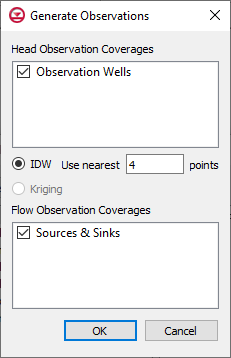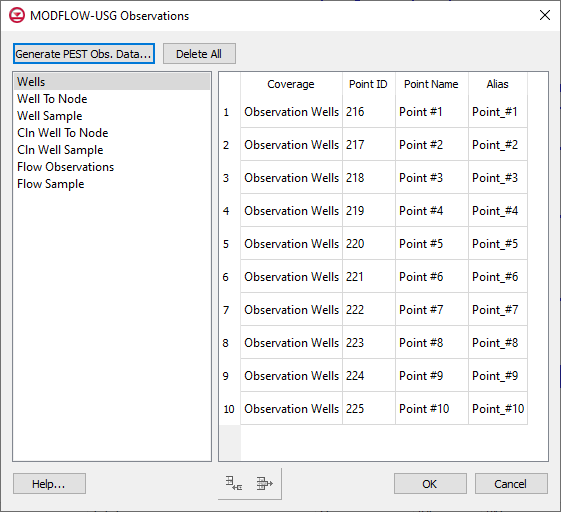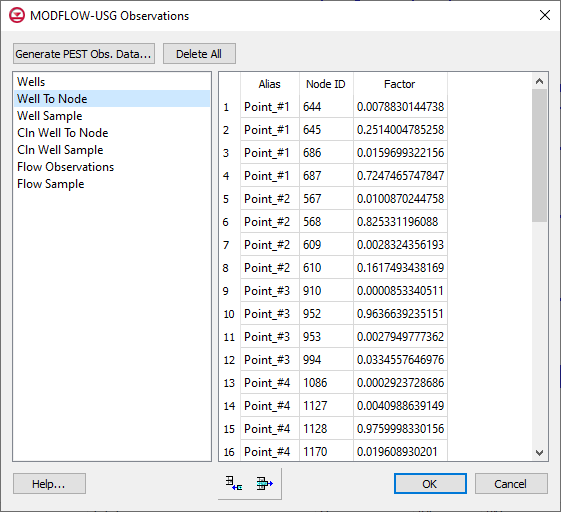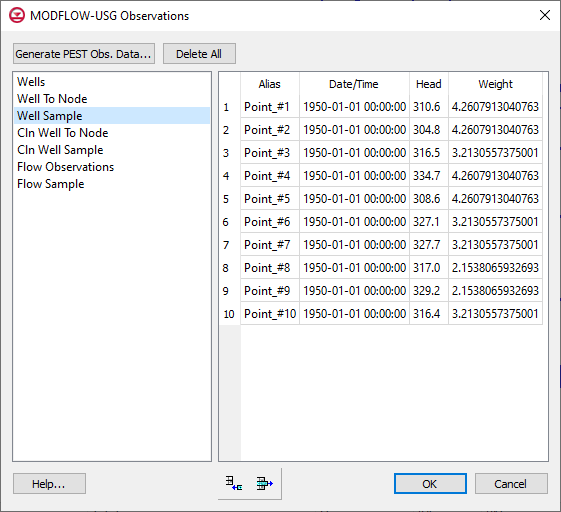GMS:MODFLOW-USG Observations: Difference between revisions
No edit summary |
No edit summary |
||
| Line 18: | Line 18: | ||
=Head Observations= | =Head Observations= | ||
The generated head observation data is stored in 3 tables: Wells, WellToNode, and WellSample. | The generated head observation data is stored in 3 tables: Wells, WellToNode, and WellSample. | ||
{|style="margin: 0 auto;" | |||
|[[Image:ObsUsgWells.png|center|250x200px|frame|Wells Table]] | |||
|[[Image:ObsUsgWell2Node.png|center|250x200px|frame|Well To Node Table]] | |||
|[[Image:ObsUsgWellSample.png|center|250x200px|frame|Well Sample Table]] | |||
|} | |||
==Wells Table== | ==Wells Table== | ||
Revision as of 15:49, 8 October 2014
MODFLOW-USG does not support an observation process as does MODFLOW 2000, 2005, NWT, ect. When using MODFLOW-USG in GMS a series of PEST utilities are run to calculate the model computed values at observations. The inputs to these utilities are managed in the MODFLOW-USG Observation dialog. This dialog contains information for Head observations as well as flow observations. The head and flow observations can be steady state or transient depending on the type of MODFLOW-USG simulation.
Generating Observation Data
Observation data is generated from coverages in the conceptual model. The generation of MODFLOW-USG observation data may occur manually by selecting the Generate PEST Obs. Data button or when using the Map->MODFLOW command.
Generate PEST Obs. Data Dialog
The Generate PEST Obs. Data dialog allows the user to select the coverages and settings used to generate observation data. The top of the dialog contains a list of coverages that have MODFLOW Head observations. Any selected coverages will be used to generate the observation data. If the MODFLOW model is steady state then only coverages with the "Head" observation property will be used (as opposed to the "Trans. Head" property). Below the list of Head observation coverages the user may specify the interpolation option to be used in calculating the model computed value at the observation points. GMS 10.1 supports IDW interpolation where the user may specify the number of nearest grid cells to use. The next section of the dialog lists coverages that have Flow observations. Similar to Head observations, if the MODFLOW model is steady state then only coverages with the "Observed Flow" BC property will be used (as opposed to the "Trans. Observed Flow" property).
NOTE: Determining MODFLOW Model Layer for Observation Points
GMS allows multiple methods for assigning observation point to MODFLOW models including: specifying the layer, using the elevation or Z of the point, or using a well screen. This option is specified in the Coverage Setup dialog under the "3D grid layer option for obs. pts." If the user chooses the well screen option then the middle of the well screen is used to find the layer of the UGrid; the nearest points in that layer are used to interpolate to the observation point.
Map->MODFLOW
When executing the Map->MODFLOW command GMS will generate observation data for any coverage that has Head Observations and any coverage that has Flow Observations.
Head Observations
The generated head observation data is stored in 3 tables: Wells, WellToNode, and WellSample.
Wells Table
The Wells table provides a list of all of the observation points found in the specified coverages. The table lists the source Coverage Name (CovName), point id (PtId), point name (PtName), and Alias. The Alias field is a string that meets the requirements for "borenames" in the PEST utilities. The alias must be unique (ignoring case), 10 characters or less, and contain no spaces. GMS generates aliases for each of the observation points. If the name of the point satisfies the alias criterion then it is used. None of the data in Wells table can be edited.
WellToNode Table
The WellToNode table lists the information necessary to interpolate from the UGrid cells to the observation point. The table lists the Alias (same as the Alias listed in the Wells table), id of the UGrid cell (NodeId), and an interpolation factor for the UGrid cell (Factor). The user may edit the values of Alias, NodeId, and Factor as desired. Alias may only be one of the Aliases specified in the Wells table. The user may also Add or Delete rows in the table.
WellSample Table
The WellSample table lists measurements taken at the observation points. The table lists the Alias (same as the Alias listed in the Wells table), the date/time that the measurement was taken (DateTime), and the value of the measurement (Head). When the MODFLOW model is steady state then the DateTime field will contain a value of 1950-01-01 00:00:00. The user may edit the values of Alias, DateTime, and Head as desired. Alias may only be one of the Aliases specified in the Wells table. Many different date time formats may be entered into the DataTime field. Regardless of the format enter, the date time will be reformatted into the YYYY-MM-DD HH:MM:SS format.
PEST Utilities for Head Observations
GMS – Groundwater Modeling System | ||
|---|---|---|
| Modules: | 2D Grid • 2D Mesh • 2D Scatter Point • 3D Grid • 3D Mesh • 3D Scatter Point • Boreholes • GIS • Map • Solid • TINs • UGrids | |
| Models: | FEFLOW • FEMWATER • HydroGeoSphere • MODAEM • MODFLOW • MODPATH • mod-PATH3DU • MT3DMS • MT3D-USGS • PEST • PHT3D • RT3D • SEAM3D • SEAWAT • SEEP2D • T-PROGS • ZONEBUDGET | |
| Aquaveo | ||



